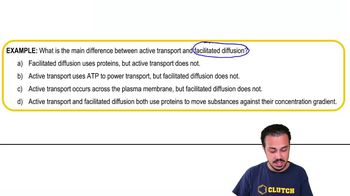Table of contents
- 1. Introduction to Biology2h 42m
- 2. Chemistry3h 40m
- 3. Water1h 26m
- 4. Biomolecules2h 23m
- 5. Cell Components2h 26m
- 6. The Membrane2h 31m
- 7. Energy and Metabolism2h 0m
- 8. Respiration2h 40m
- 9. Photosynthesis2h 49m
- 10. Cell Signaling59m
- 11. Cell Division2h 47m
- 12. Meiosis2h 0m
- 13. Mendelian Genetics4h 44m
- Introduction to Mendel's Experiments7m
- Genotype vs. Phenotype17m
- Punnett Squares13m
- Mendel's Experiments26m
- Mendel's Laws18m
- Monohybrid Crosses19m
- Test Crosses14m
- Dihybrid Crosses20m
- Punnett Square Probability26m
- Incomplete Dominance vs. Codominance20m
- Epistasis7m
- Non-Mendelian Genetics12m
- Pedigrees6m
- Autosomal Inheritance21m
- Sex-Linked Inheritance43m
- X-Inactivation9m
- 14. DNA Synthesis2h 27m
- 15. Gene Expression3h 20m
- 16. Regulation of Expression3h 31m
- Introduction to Regulation of Gene Expression13m
- Prokaryotic Gene Regulation via Operons27m
- The Lac Operon21m
- Glucose's Impact on Lac Operon25m
- The Trp Operon20m
- Review of the Lac Operon & Trp Operon11m
- Introduction to Eukaryotic Gene Regulation9m
- Eukaryotic Chromatin Modifications16m
- Eukaryotic Transcriptional Control22m
- Eukaryotic Post-Transcriptional Regulation28m
- Eukaryotic Post-Translational Regulation13m
- 17. Viruses37m
- 18. Biotechnology2h 58m
- 19. Genomics17m
- 20. Development1h 5m
- 21. Evolution3h 1m
- 22. Evolution of Populations3h 52m
- 23. Speciation1h 37m
- 24. History of Life on Earth2h 6m
- 25. Phylogeny2h 31m
- 26. Prokaryotes4h 59m
- 27. Protists1h 12m
- 28. Plants1h 22m
- 29. Fungi36m
- 30. Overview of Animals34m
- 31. Invertebrates1h 2m
- 32. Vertebrates50m
- 33. Plant Anatomy1h 3m
- 34. Vascular Plant Transport1h 2m
- 35. Soil37m
- 36. Plant Reproduction47m
- 37. Plant Sensation and Response1h 9m
- 38. Animal Form and Function1h 19m
- 39. Digestive System1h 10m
- 40. Circulatory System1h 57m
- 41. Immune System1h 12m
- 42. Osmoregulation and Excretion50m
- 43. Endocrine System1h 4m
- 44. Animal Reproduction1h 2m
- 45. Nervous System1h 55m
- 46. Sensory Systems46m
- 47. Muscle Systems23m
- 48. Ecology3h 11m
- Introduction to Ecology20m
- Biogeography14m
- Earth's Climate Patterns50m
- Introduction to Terrestrial Biomes10m
- Terrestrial Biomes: Near Equator13m
- Terrestrial Biomes: Temperate Regions10m
- Terrestrial Biomes: Northern Regions15m
- Introduction to Aquatic Biomes27m
- Freshwater Aquatic Biomes14m
- Marine Aquatic Biomes13m
- 49. Animal Behavior28m
- 50. Population Ecology3h 41m
- Introduction to Population Ecology28m
- Population Sampling Methods23m
- Life History12m
- Population Demography17m
- Factors Limiting Population Growth14m
- Introduction to Population Growth Models22m
- Linear Population Growth6m
- Exponential Population Growth29m
- Logistic Population Growth32m
- r/K Selection10m
- The Human Population22m
- 51. Community Ecology2h 46m
- Introduction to Community Ecology2m
- Introduction to Community Interactions9m
- Community Interactions: Competition (-/-)38m
- Community Interactions: Exploitation (+/-)23m
- Community Interactions: Mutualism (+/+) & Commensalism (+/0)9m
- Community Structure35m
- Community Dynamics26m
- Geographic Impact on Communities21m
- 52. Ecosystems2h 36m
- 53. Conservation Biology24m
6. The Membrane
Active Transport
Problem 9`
Textbook Question
Which of the following forms of membrane transport require specific membrane proteins?
a. Diffusion
b. Exocytosis
c. Facilitated diffusion
d. Active transport
e. Facilitated diffusion and active transport
 Verified step by step guidance
Verified step by step guidance1
Understand the different types of membrane transport mechanisms: Diffusion is the passive movement of molecules from high to low concentration without requiring membrane proteins. Exocytosis involves vesicle fusion with the membrane to release contents and does not require specific membrane proteins for transport. Facilitated diffusion and active transport, however, both require specific membrane proteins.
Recall that facilitated diffusion is a passive transport mechanism where molecules move down their concentration gradient with the help of specific membrane proteins, such as channel or carrier proteins.
Recognize that active transport is an energy-dependent process where molecules are moved against their concentration gradient using specific membrane proteins, often referred to as pumps (e.g., sodium-potassium pump).
Analyze the options provided: Diffusion and exocytosis do not require specific membrane proteins for transport, while facilitated diffusion and active transport do.
Conclude that the correct answer is the option that includes both facilitated diffusion and active transport, as these are the forms of membrane transport requiring specific membrane proteins.
 Verified video answer for a similar problem:
Verified video answer for a similar problem:This video solution was recommended by our tutors as helpful for the problem above
Video duration:
35sPlay a video:
Was this helpful?
Key Concepts
Here are the essential concepts you must grasp in order to answer the question correctly.
Membrane Transport
Membrane transport refers to the mechanisms by which substances move across the cell membrane. This process is crucial for maintaining cellular homeostasis and involves various methods, including passive and active transport. Understanding these mechanisms helps in grasping how cells interact with their environment and regulate internal conditions.
Recommended video:
Guided course

Introduction to Membrane Transport
Facilitated Diffusion
Facilitated diffusion is a type of passive transport that requires specific membrane proteins to help move molecules across the cell membrane. Unlike simple diffusion, which occurs directly through the lipid bilayer, facilitated diffusion allows larger or polar molecules, such as glucose, to enter or exit the cell efficiently. This process does not require energy, as it relies on the concentration gradient.
Recommended video:
Guided course

Simple and Facilitated Diffusion
Active Transport
Active transport is a process that moves substances against their concentration gradient, requiring energy, usually in the form of ATP. This mechanism is essential for maintaining concentration differences of ions and molecules across the membrane, which is vital for various cellular functions. Specific membrane proteins, such as pumps, are involved in this process, making it distinct from passive transport methods.
Recommended video:
Guided course

Active Transport
Related Videos
Related Practice














